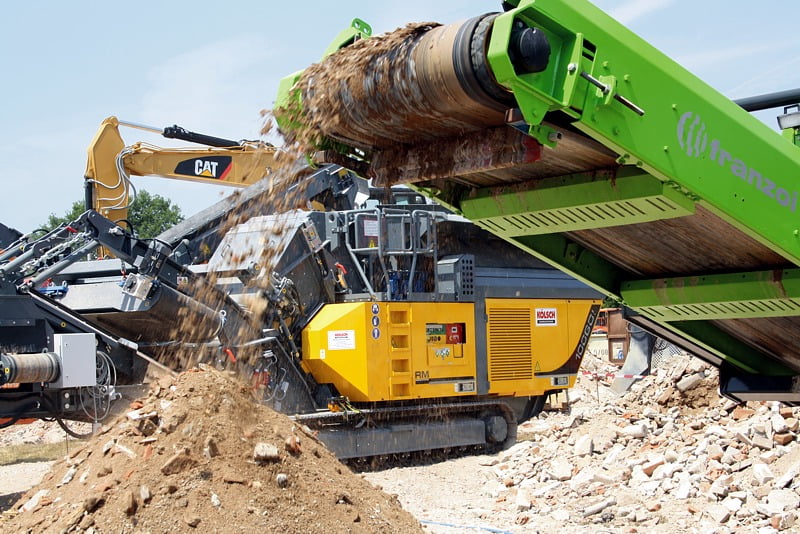Recycle and reuse of construction waste materials: The growth of Indian economy has brought with it a significant increase in construction activities. These increased construction activities have further highlighted the problem of waste generation on construction sites. Over 90% of construction waste is used as land-fills which include debris, rubble, earth, and concrete which is suitable for land reclamation and site formation. Construction activity leads to the generation of solid wastes, which include sand, gravel, concrete, stone, bricks, wood, metal, glass, plastic, paper, etc.
Reuse of waste materials in new construction

When adequately sorted, materials such as concrete and asphalt can be recycled for use in construction. The remaining waste includes bamboo, timber, and other organic materials which are not suitable for land reclamation and are disposed of at landfills.
The management of construction and demolition waste is a big concern due to a shortage of dumping sites, increase in transportation and disposal cost and above all growing concern about pollution and environmental deterioration.
The problem grows in Congested construction sites with high built‐up areas and with no other storage or staging location for materials. Due to lack of awareness and education among the construction workforce, the implementation of waste minimization practices in India is difficult.
Recycling and reuse of building construction waste in construction project
The adoption of reuse/recycling strategy is a key to the mounting problems of construction waste management. The reduced extraction of raw materials, reduced transportation cost, improved profits and reduced environmental impact are some other reasons for the adoption of such policy.
Throughout the construction, process waste is generated at different stages. Waste during construction activity relates to excessive cement mix or concrete left after work is over, rejection/ demolition caused due to change in design or wrong artistry, etc.
Concrete is also wasted a lot in structural elements of the building have reinforced concrete and in foundations having mass non-reinforced concrete zones.
CSEB – Compressed Stabilized Earth Blocks
Excavations were done produce topsoil, clay, sand, and gravel which can be re-used as filler at the same site or can be used to make CSEB (Compressed Stabilized Earth Blocks) and mud shuttering.
A large number of bricks and masonry arise as construction waste during demolition. These are generally mixed with cement, mortar or lime.
Stone originates during excavations or by the demolition of old buildings.
Metal waste from pipes, conduits wires, and sanitary fittings can be recovered and recycled by re-melting.
Timber doors, window frames, partitions if in good condition is often treated with chemicals to prevent termite infestation and warrants special care during disposal. Other material wastes include glass, plastic material, paper, etc.
Items recovered during demolition are sold in the market at a discount concerning the price of the new material.
Sometimes, Wood carvings and Marble structures are recovered from old buildings, which fetch an excellent price as Antique piece in Domestic/ Export market.
Recycled Plastic Bottle House
Although the responsibility for removing the waste is primarily of the builder or the owner, it is usually assigned to the demolition contractor. Items, which cannot be re-used, are disposed of to landfill site.
The management of solid waste is in the hands of Municipal bodies.
Once at the plant, the waste is segregated into big concrete pieces, mixed C&D waste as per size and un-recyclable materials like plastic and wood, which are sent to a waste-to-energy plant in Okhla.
The plant uses manual segregation for more significant plastic pieces as well as a magnetic separator for metallic objects. The waste is crushed, washed and used to make ready-mix concrete, cement bricks, pavement blocks, hollow bricks and manufactured sand.
Not only does the plant reduce the load at landfills, but it is also better for the environment as it uses treated effluent supplied from the Delhi Jal Board.
India’s first and only recycling plant for construction and demolition (C&D) waste was constructed recently in Delhi which saved the already-polluted Yamuna and the overflowing landfills of Delhi from 15.4 lakh tons of debris.
The national capital region is always in a near-constant buzz of construction activity across the Capital, 5,000 tons of waste is produced by building, demolition and land-clearing activities every day.
Though the plant was set up with 500 tons per day (TPD) capacity, it has more than doubled today.
Concepts for reuse and recycling of construction and demolition waste
Interestingly we as architects can incorporate waste in our buildings as a substitute to landfills. It is opposite of the typical scenario of placing wet waste in a plastic bag and throwing out to rot or for animals to ingest. Otherwise thrown in a landfill and with exposure to rain and heat can produce leach-ate.
If we bury the waste under the buildings on low water table areas, the waste will not be exposed to sun and rain and will work as damp roofing. The foundation in a weak soil requires an economical design.
The old processed concrete from the demolished building can be used to make plum concrete. Well, foundations utilizing this plum concrete can support grade beams on which the building can be rested.
This alternative to the conventional foundation serves not only as an elegant solution to a specific problem but also helps reduce the waste generated from the site going and defacing someone else backyard.
Mud Shuttering
In India contractor executes construction project on a labor contract basis, predominantly small housing projects. The projects of such nature require strict supervision to control construction waste generation during the construction process.
Typically, waste generation ranges from 5 to 7%. In larger projects, where execution is by one’s team of professionals, material wastage is within 3%.
Filler Slab
After a building is constructed, it lies on land which is no longer productive. Thus foundation, plinth, in-fills, sunken floors, etc. are ideal for holding waste.
The house made by biome-solutions where they used discarded keyboards in a filler slab as a sink of plastic and e-waste. Also, new buildings can be seen as a sink for debris and construction waste of demolished buildings. The various materials obtained from old buildings reused in foundations, walls, windows or made into an art piece.
So next time think carefully about the construction waste we generate and how to use it wisely.






